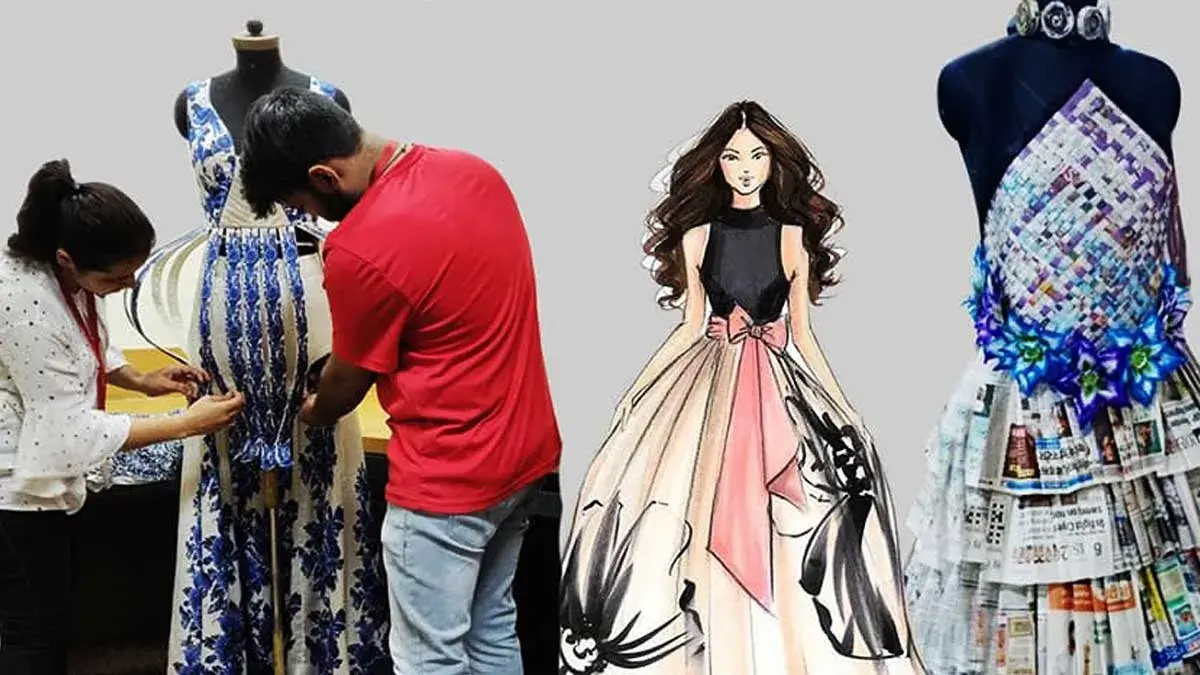A diploma in fashion designing is a specialized program that focuses on providing students with comprehensive knowledge and skills in the field of fashion design. It is a course that equips individuals with the necessary foundation and practical training to pursue a career in the fashion industry.
Course Duration:
The duration of a diploma in fashion designing can vary depending on the institute and program structure. It typically ranges from 1 to 3 years.Course Curriculum:
The curriculum of a fashion designing diploma covers a wide range of subjects related to the fashion industry. It includes design principles, garment construction techniques, pattern making, fashion illustration, textile knowledge, fashion history, trend analysis, and computer-aided design (CAD) software.The curriculum for a diploma in fashion designing can vary depending on the institute and the specific program. However, here are some common subjects and topics that are typically covered in a fashion designing diploma curriculum:
1. Design Principles: Introduction to the basic principles of design, including color theory, balance, proportion, line, shape, and form.
2. Fashion Illustration: Developing skills in sketching and drawing fashion figures, rendering fabrics, and creating fashion illustrations.
3. Pattern Making and Garment Construction: Understanding the process of creating patterns for different garments, draping techniques, and construction methods.
4. Textile Science: Study of various fabrics, textiles, and their characteristics. Learning about fabric selection, understanding fabric drape, texture, and properties.
5. Fashion Design History: Exploring the history of fashion, key fashion movements, and influential designers throughout different eras.
6. Fashion Trend Analysis: Understanding fashion trends and forecasting techniques. Analyzing consumer behavior, market research, and trend prediction.
7. Fashion Merchandising: Introduction to fashion merchandising and marketing principles. Learning about retailing, product development, and visual merchandising.
8. Fashion Communication: Developing skills in fashion communication through visual presentation techniques, mood boards, and portfolio development.
9. Computer-Aided Design (CAD): Utilizing software like Adobe Illustrator or other design software for fashion illustration, pattern making, and digital design.
10. Apparel Production and Quality Control: Understanding the process of apparel production, quality control measures, and production planning.
11. Fashion Portfolio Development: Creating a professional portfolio showcasing the student's design skills, projects, and creative abilities.
12. Industry Projects and Internships: Gaining practical experience through industry projects, fashion shows, exhibitions, or internships to apply classroom learning in real-world scenarios.
3. Practical Training:
A diploma program in fashion designing emphasizes practical training to develop the necessary skills. Students are exposed to hands-on learning through projects, design workshops, fashion shows, and internships. They learn about fabric selection, draping, sketching, sewing, and creating fashion prototypes.4. Specializations:
Some diploma programs offer specialization options within fashion designing, allowing students to focus on specific areas such as apparel design, accessory design, textile design, fashion styling, or fashion merchandising. Specializations provide in-depth knowledge and skills in a particular field.5. Industry Exposure:
Many diploma programs include industry exposure activities such as fashion shows, exhibitions, industry visits, and interactions with industry experts. These opportunities help students understand the industry dynamics, trends, and network with professionals.6. Portfolio Development:
A crucial aspect of a fashion designing diploma is the development of a strong portfolio. Students work on design projects and create a portfolio showcasing their creative abilities, technical skills, and design aesthetics. A well-curated portfolio plays a significant role in securing internships or job opportunities.7. Career Opportunities:
Upon completing a diploma in fashion designing, graduates can explore various career paths in the fashion industry. They can work as fashion designers, apparel merchandisers, fashion stylists, fashion illustrators, pattern makers, textile designers, or start their own fashion labels or businesses.Fashion Designer: As a fashion designer, you can create your own fashion lines or work for established fashion brands. You'll be responsible for conceptualizing designs, creating sketches, selecting fabrics, and overseeing the garment production process.
Fashion Illustrator: Fashion illustrators create visual representations of fashion designs. They work closely with fashion designers to bring their concepts to life through detailed and expressive illustrations.
Apparel Merchandiser: Apparel merchandisers are involved in the business and marketing aspects of the fashion industry. They analyze market trends, develop product strategies, manage inventory, and ensure that the right products are available at the right time.
Fashion Stylist: Fashion stylists work with individuals, brands, or publications to create visually appealing looks for fashion shoots, events, or personal styling. They curate outfits, select accessories, and ensure that the overall aesthetic aligns with the desired vision.
Pattern Maker: Pattern makers create patterns based on fashion design sketches, allowing garments to be constructed accurately. They work with precision to develop patterns that translate design concepts into wearable garments.
Textile Designer: Textile designers specialize in creating patterns and designs for fabrics. They develop unique prints, motifs, and textures that are used in clothing, home furnishings, and other textile products.
Fashion Entrepreneur: With a diploma in fashion designing, you have the option to start your own fashion label or business. This involves managing all aspects of the business, including design, production, marketing, and sales.
Fashion Buyer: Fashion buyers are responsible for selecting and purchasing fashion products for retail stores or fashion brands. They analyze market trends, negotiate with suppliers, and ensure that the inventory meets the demands of the target market.
Fashion Consultant: Fashion consultants provide expert advice to individuals or businesses on style, wardrobe choices, fashion trends, and personal branding. They help clients enhance their overall image and achieve their fashion goals.
Fashion Educator: With further experience and education, you can pursue a career in fashion education. This involves teaching fashion design, conducting workshops, or working as a guest faculty member in fashion institutes.
It's important to note that the exact curriculum, duration, and specialization options may vary between different institutes offering fashion designing diploma programs. It is advisable to research and choose a program that aligns with your interests, goals, and the reputation of the institute.

